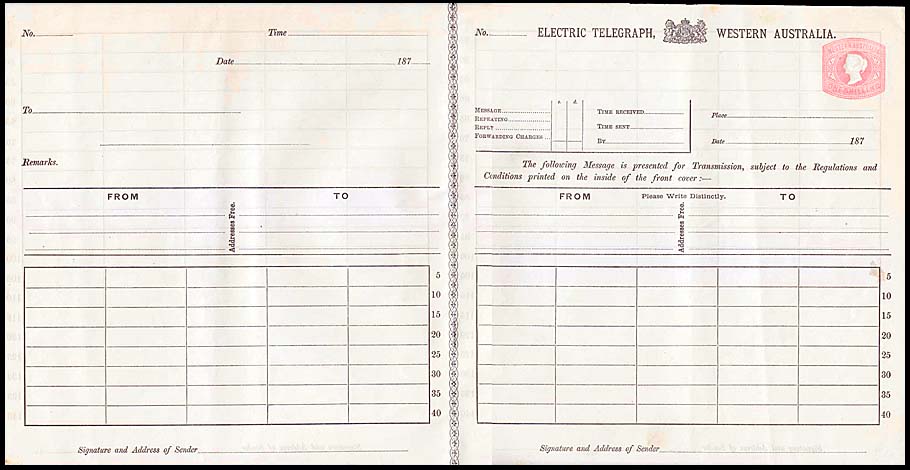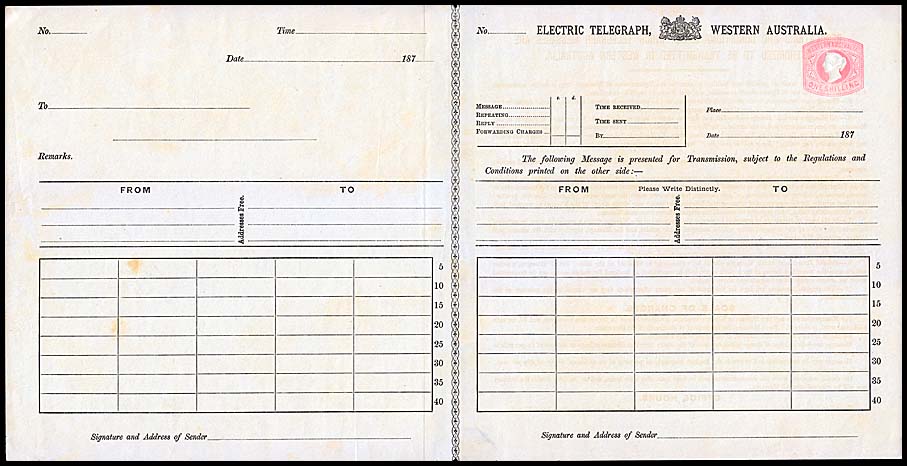Transmission form: WC-TO-2.
- Home, index, site details
- Australia 1901-1988
-
New South Wales
- Overview of NSW
- Telegraph lines
- Telegraph Offices
- Date stamps
- Forms
- Envelopes
- Instructional annotation
- Collect
- Delayed
- Free
- Immediate Urgent
- Reply paid
- Rates
- Stamps
- 1871 Telegraph stamps
- 1885 proposal
- 1893 proposal
- Queensland
- South Australia
- Tasmania
- Victoria
- Western Australia
- International
- Special aspects
| Heading and notes: | No form number ELECTRIC TELEGRAPH WESTERN AUSTRALIA surrounds the Crest. |
| Message area: | 8 lines of five boxes. |
| Reverse side: | Either more boxes for message (TO-2A) or Regulations and Charges (TO-2B). |
| Colours (text & form): | Black on white with pink embossed image. |
| Size of form overall: | 2A: 207 × 403 mm. 2B: 211 × 412 mm. (both including centre separation serration). |
- double sided form in two halves - with the left side as a copy/receipt for the message;
- has a 1/- pink embossed image in top right corner;
- the main distinctions amongst the varieties are:
2A: section at the bottom of the heading finishes with "... inside of the front cover";
2B: section at the bottom of the heading finishes with "... on the other side".
- Victoria was the first Australian Colony to issue a transmission form with a pre-printed indicium (VC-TO-6) to prepay telegraph charges in 1873.
- Queensland issued its Postal Note transmission form (QC-TO-4) in 1880 and its pre-stamped transmission form (QC-TO-5) in 1882.
- New South Wales issued its 6d and 1/- indiciums printed on transmission forms (in 1893).
Orders were placed by the Colonial Government in July 1878 with De La Rue for the design and supply of embossed Telegraph forms and two Telegraph stamps. The Western Australian Times of Friday 19 July 1878 reported that "In the Legislative Council on Tuesday:
messages were received from His Excellency
the Governor notifying that orders had
been sent home for the manufacture and
supply of postal cards and embossed telegraph
forms".
Details of the development of the embossing die as well as the use of the embossed image philatelically is presented elsewhere. The order was invoiced on 1 February 1879 and supplies were probably received in the Colony during March 1879.
Postmaster Helmich gazetted the use of both the forms and the stamps on 9 April 1879:
"Notice is hereby given that impressed stamp telegraph message forms and adhesive telegraph stamps, which may be used in payment for telegraphic messages, have been obtained from England and may be procured at the General Post Office and the Post and Telegraph Offices throughout the Colony".
The embossed telegraph forms were available either as single forms or bound into books of 20 forms.
WC-TO-2A. Reverse side has boxes number at the right to 140. |
WC-TO-2B. Reverse side (behind indicium) has Regulations and Scale of Charges while the reverse side of other half is blank. The sheet form is rarer than the form taken from a book. Status Auctions February 2007 Lot 1791 offered a sheet form without counterfoil. |
Number used and subsequent use.
No estimate of how many embossed forms were actually used for telegram transmission forms can be made - nor how many may have been sold in either sheet form or in books. One estimate was that:
- 50,000 forms were printed singly of which 8,000 were used; and
- 250 books of 20 forms were prepared of which 138 books were used.
In 1897, in a discussion of how used stamps could be "resuscitated" for re-use, mention is made that "The Telegraph Department formerly sold their telegraph forms, with the stamps attached, for waste paper. That practice has been stopped in view of recent discoveries, and the forms and defaced stamps are now destroyed in the office itself"
(The West Australian, 21 January1897).
In 1902, someone in the Post and Telegraph Office was wondering if there were any stamped telegraph forms still in stock. It was subsequently determined that "there should be" approximately 42,000 single forms remaining (compared to 25,000 having been printed) and 2,242 books of 20 forms each (compared to the 250 books which were prepared for the 5,000 bound forms). There must have therefore been a second order but it is not recorded.
The response to the inquiry said that the forms should be regarded as obsolete and written off but there was no record of them being destroyed or where they might be.
Someone did however know where at least some forms had been hidden - Frank Lewis Dolton. Mr. Dolton's actions show that at least 22 books of embossed telegraph forms were still in stock in 1905!!! Nothing has been heard since.
New Suggestion.
Meanwhile, after the 1902 Commonwealth Act came into force, the Western Australian public (and the rest of Australia) were "forced" to purchases stamps to affix to the telegram transmission forms. One frustrated WA person suggested an excellent idea - why not have a telegram form with a 1/- embossed image! His letter to the Editor read:
EMBOSSED TELEGRAPH FORMS.
West Australian, 12 October 1904
To the Editor. Sir,
I would like to make a suggestion which, I am sure, would benefit the Postal Department and save considerable time to the public, and, incidentally, much impiety on the part of travellers hurrying to catch a train. The suggestion I would make is that telegraph forms be either stamped with a 9d stamp or embossed, as I take it the majority of telegrams sent cost that amount.
The rules of the service are that the sender has to attach stamps, and I can speak from experience of the inconvenience caused. On one occasion I had to forfeit my change, because I could not wait while the rather supercilious lady attendant leisurely went about her business, quite regardless of my hurry to catch the train. I hurriedly suggested she should attach the stamp but she lifted up her eyebrows and said "Against the rules". You can imagine I did not feel too kindly towards the system, for these unnecessary rules of red tape do not tend to piety. I hope the Department will adopt my suggestion, as, I feel sure hundreds of busy travellers could bear me out as to the inconvenience caused.
Yours, etc., JANIUS.
Perth, October 11.
Details of use and rarity.
| Form sub-number |
Schedule number | Earliest recorded date | Rarity rating |
| TO-2A | None | Unknown used. | R even unused. |
| TO-2B | None | Unknown used. |

 Front of a form printed in single sheets. The text above FROM and TO finishes with "..printed on the other side".
Front of a form printed in single sheets. The text above FROM and TO finishes with "..printed on the other side".